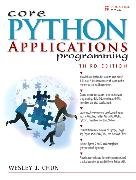KlappentextThe Complete Developer's Guide to Python
Python is an agile, robust, and expressive programming language that continues to build momentum. It combines the power of compiled languages with the simplicity and rapid development of scripting languages. In Core Python Applications Programming, Third Edition, leading Python developer and corporate trainer Wesley Chun helps you take your Python knowledge to the next level.
This book has everything you need to become a versatile Python developer. You will be introduced to multiple areas of application development and gain knowledge that can be immediately applied to projects, and you will find code samples in both Python 2 and 3, including migration tips if that's on your roadmap too. Some snippets will even run unmodified on 2.x or 3.x.
ZusammenfassungRev. ed. of: Core Python programming / Wesley J. Chun. c2007.

